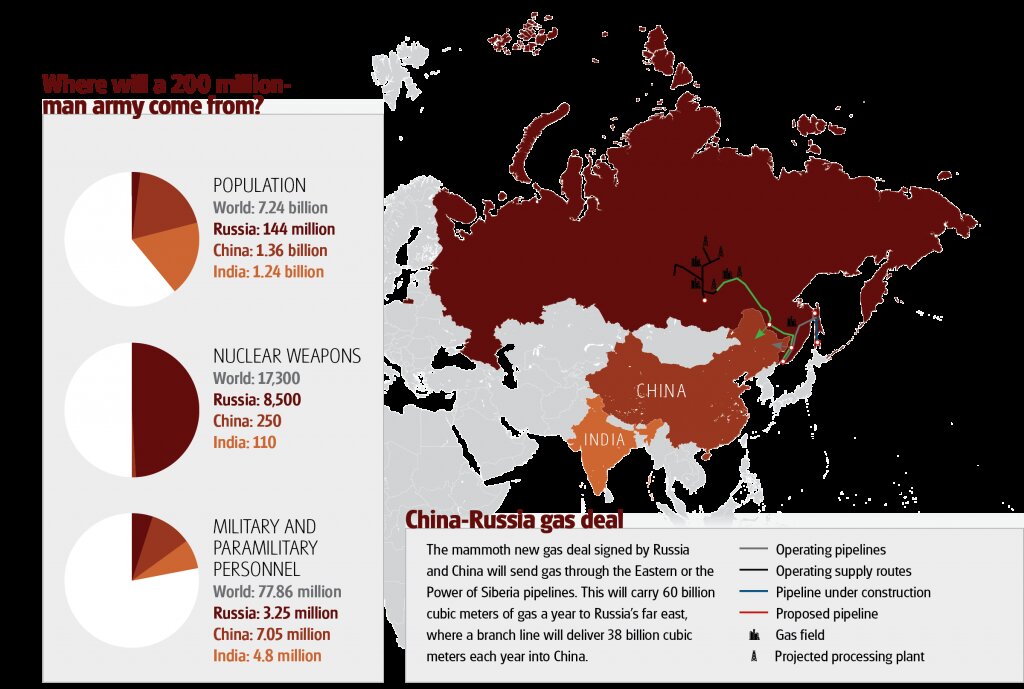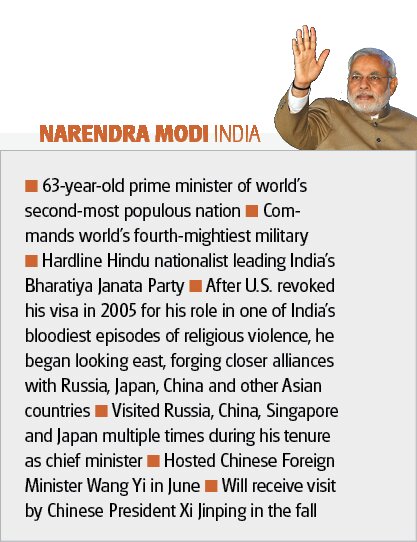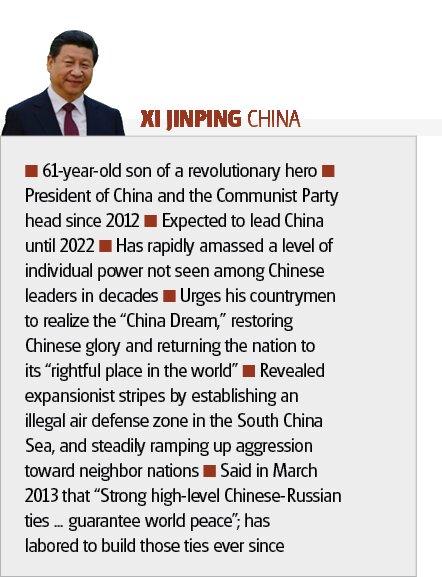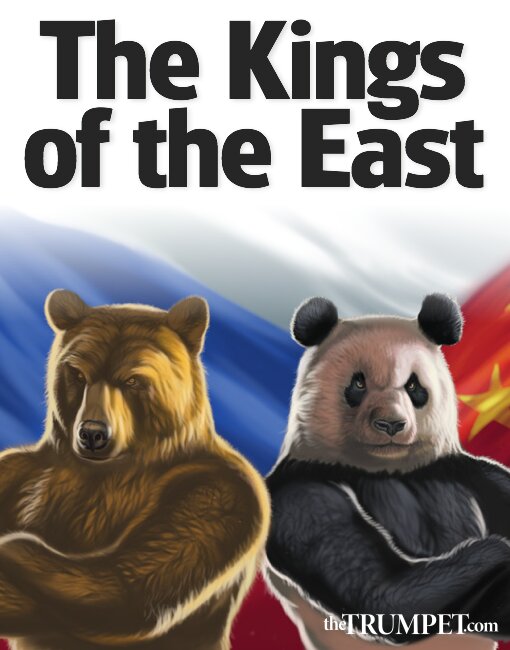The Rise of Asia
Together, they comprise well over one third of the world’s population. They are responsible for a third of the world’s energy production. They make up over a fifth of the world’s standing army, and almost a fifth of total global exports.
Individually, Russia, China and India tend to be dismissed by America and other Western nations as second- and third-rate powers. Together, however, they have the potential to be the fiercest force on Earth.
And recent headlines—including human history’s biggest election and its largest-ever business transaction—show that these nations are increasingly joining forces, uniting, acting as one. The ramifications for the global order are immense.
Russian-Chinese Cooperation
“This is a major change,” said Vasily Kashin, a senior research fellow at the Moscow-based Center for Analysis of Strategies and Technologies, who spoke to the Trumpet on June 7. The change he refers to is the sudden intensification in cooperation between Russia and China. It is so “major” that it is taking many Western officials and analysts by surprise.
Evidence of the change became undeniable during Russian President Vladimir Putin’s visit to China in late May. There, he and Chinese President Xi Jinping signed a natural gas deal worth $400 billion—the largest business transaction in human history. That same week, as if to punctuate the historic deal with an italicized exclamation mark, the navies of Russia and China conducted a massive joint drill in the East China Sea, sending a clear deterrence message to the United States. At the same time, Moscow announced that, within a year, bilateral trade between Russia and China will reach $100 billion annually—considerably earlier than anticipated. Within the same week, Russia and China vetoed a key draft United Nations resolution sending Syria to the International Criminal Court for war crimes.
All of this came just weeks after China (along with India) stunned the West by revealing that it supported Putin’s illegal takeover of the Crimean Peninsula.
These are not everyday geopolitical events, but milestone occurrences. And they are sending geopolitical fissures radiating all over the globe, redirecting global energy flows, reorienting strategic alignments, and even redrawing national borders.

“It would be no exaggeration if I said that the cooperation between our two countries is at its highest level in history,” Putin said on May 20. It is difficult to argue with that statement.
In this climate of unprecedented cooperation between Russia and China, some analysts are predicting the two could enter into a formal alliance, or something quite near it. Whether the close strategic cooperation culminates in a formal, anti-Western alliance or not, the significance of this trend cannot be overstated.
The seismic nature of this shift can be measured by just how much it has caught most analysts and officials off guard. Historically, the cultural dissonance between Russia and China, their conflicting interests in Central Asia, and their long history of mutual suspicion and animosity made many believe such alignment impossible (see “From Contempt to Camaraderie”). Nevertheless, it is happening.
The Elephant Enters the Tango
While Russia and China are at the heart of the congealing Asian axis, another deeply significant aspect is the decision of India to lean toward it, and away from the cooperation with the United States that has defined Delhi’s foreign policy for decades.
On May 12, following five weeks of voting and 800 million ballots cast, the largest election in the history of mankind came to an end. Its result was a landslide victory for Indian Hindu nationalist Narendra Modi. The massive win gave Modi something no ruler of India has had for over 30 years: an absolute majority in the lower house of parliament. This awarded him powers his predecessors could only have dreamed of. And indications are that he is already using those powers to steer India away from the U.S. and nearer to Russia, China and other Asian states.
Part of the reason for this realignment dates back to 2005, when America revoked Modi’s visa on grounds that he had played a role in one of India’s bloodiest episodes of religious violence. Modi responded to the Western snub by looking east. Ever since, he has been making friends and forging alliances with China, Russia, Japan and other Asian countries.

The South China Morning Post explained that his win represented a bane to the U.S. and a boon for Eastern powers: “Over the years, China and Modi have invested heavily in each other and forged a bond that could have far-reaching ramifications not only for Sino-Indian relations, but also for the U.S. ‘Asia pivot’ strategy at a time when territorial disputes in the South China Sea are taking a violent turn. … Modi is also known to have an Eastern bias, with Asian nationalism forming the core of his worldview. Apart from China, that also draws him closer to Japan and Singapore, with whose leaders he has struck up a similar rapport. … Modi’s unimpeachable conservative background and open admiration for China has in the past raised hopes of him becoming a sort of Indian Richard Nixon” (May 16).
Nixon is not the only world leader Modi has been compared to. The Diplomat called him “India’s Shinzo Abe” because some of his nationalistic leanings mirror those of the Japanese prime minister. The Economic Times said many Chinese officials who have dealt with Modi “compare him to their present boss, Xi Jinping.” OneIndia News skipped to the chase, likening Modi to Asia’s big man himself; he is “India’s Putin,” the publication wrote. His heavy-handed leadership “may revive India as Putin did in Russia,” it said, “[because] Modi has similar Putin-like capability to metamorphose India into an economic and military powerhouse through a series of tough measures and steps which would help India leverage and unleash its real potential” (May 6).
Welcome, Comrade!
At the heart of the warming ties between Russia, China and India has been increasing fear of and contempt for the West, especially for a world order steered by the U.S. The sanctions Western powers have slapped on Russia have had a catalytic effect on Asian bonding.
Modi—with a worldview chiseled primarily by Asian nationalism—joins Putin, Xi and other Asian strongman leaders who have been rising to power (or consolidating power) as disdain for America intensifies and as America’s global influence fades. Modi’s fellow strongmen eagerly welcome him as the newest participant in their shared goal of ending America’s global hegemony, and shifting global power from Occident to Orient.
After his election was announced, China’s state-run Global Times wrote: “This has caused worries from the West. … The U.S. is particularly upset with the enhanced strategic cooperation among China, Russia and India” (May 5).

China and India continue to bicker over such issues as border disputes, bilateral trade imbalance and Beijing’s alliance with India’s Pakistani nemesis. But under Modi, these tensions will likely abate. This fall, President Xi is scheduled to visit Modi, which is expected to hasten the trend.
Russia, too, welcomes the ascension to power of its longtime Indian friend. Just after the election results were announced, Putin said he hopes he and Modi will push Russia-India ties to “new heights.” Modi replied on Twitter, saying, “I thank President Putin for his good wishes. Looking forward to making our relations with Russia even stronger in the years to come.”
India has had a near-alliance with Moscow since the early 1970s, and has for much of that time been the number one market for Russian weaponry. In April this year, just after Putin’s annexation of Crimea, India announced plans to build a $30 billion oil pipeline with Russia that runs through China’s restive Xinjiang province. If successful, the pipeline will be the most expensive in the world. “The recent unease in both the U.S. and Europe over Russian President Vladimir Putin’s … annexation of Crimea has only added to Moscow’s efforts to diversify its markets beyond Europe,” said John Daly, ceo of U.S.-Central Asia Biofuels Ltd., after the announcement.
Under Modi, the already robust Russo-Indian relationship could effloresce into something stunning.
Europe Watches Warily
Although Washington is doing its best to ignore Asia’s coalescence, European leaders see it clearly. They understand that Russia is re-orienting itself away from Europe and recognize that the unprecedented cooperation among Asian powerhouses is creating a new balance of power in the global system. Many of them also see that Putin’s desire to rebuild a Russian empire poses a great potential threat to their own nations. This is what provoked Poland’s prime minister at the end of May to say, “The world stands on the brink of conflict.”
The Europeans—especially Eastern Europeans—can see the danger in Russia’s expansionism because it is their neighbor, and they fear that one of their nations may be the next item on the bear’s menu. In a recent interview with the Trumpet, Žygimantas Pavilionis, Lithuania’s ambassador to the U.S., voiced a viewpoint shared by many Europeans: “We have to draw the line before the Russians move tanks on top of it,” he said. “If we do nothing today, we will regret it.”
Mr. Pavilionis and a growing number of Europeans see an intensifying need to withstand Russia. And many of them see that the nations of Europe won’t receive adequate help from America, and that they instead need to unite and work together.
Russia’s recent moves, according to Mr. Pavilionis, are prompting Europe to do exactly that: “Paradoxically, Putin made a big strategic mistake in invading Ukraine: It united Europe very much. It made us think more strategically, and made us consider things that we would not have a few years ago. … After what happened, and after seeing people die in the streets of Kiev in pursuit of freedom, we said Europe must enlarge and cooperate.”
At present, the European Union still moves at roughly the speed of molasses. But it is feeling the seismic shifts underway, and will respond. This response will be a sustained drive to unite Europe in order to check the rising Asian bloc.
Did Anyone See It Coming?
News of game-changing cooperation between Russia and China has become so commonplace in recent months that only the largest events—such as Beijing’s support of Putin’s landgrab in Ukraine—now receive much attention in the Western press. Most anyone with a finger resting even gently on the pulse of current events can feel the Russo-Chinese relationship rapidly congealing.
But one certain analyst predicted this development from a long way off—before almost any evidence existed.
Even during those early Cold War years, when the only interaction between the Russian bear and the Chinese dragon was bickering about which shade of red was the correct one for communism, this lone pundit said the two would lay aside their differences and enter a phase of close cooperation.
Even after the severe tensions of the 1960s culminated in bloody war, prompting Moscow and Beijing to sever relations, this maverick forecaster clung tenaciously to his prediction.

And even after it became clear that the two Asian giants were stuck in decades of tired rivalry to see which would triumph in achieving the one “true” communism, this commentator’s forecasts only became bolder.
The analyst was Herbert W. Armstrong.
“Russia’s program … calls first for the seizure of Asia,” Mr. Armstrong’s Plain Truth magazine wrote back in December of 1959. It went on to say that China would voluntarily join a Russia-led Asian bloc as a step toward its long-term goals: “[C]hina’s … constant dream for centuries has been ultimate world conquest! … China knows, however, that in this highly industrialized age she can accomplish this dream only as an ally of Russia. … China is now ready to begin devouring the rest of Asia with Russia’s secret military backing.”
That was just one of dozens of statements Mr. Armstrong and his newsmagazine made from 1934 until his death in 1986, predicting that Russia and China would lay aside their differences to form a coalition.
At the time of Mr. Armstrong’s death in 1986, Moscow and Beijing’s relationship remained cool, but events since then—and especially just since Russia annexed Crimea—have proven that Mr. Armstrong’s unpopular and seemingly impossible forecast was actually spot on.
How could he have predicted the modern reality with such stunning accuracy? Because his primary intelligence source was one totally unlike that of other forecasters. It was the sure word of Bible prophecy. His reliance on Scripture enabled him to see truths others were blind to and to predict events from afar which are now coming to pass.
For a fascinating study of the specifics of his predictions about Asia and of the biblical passages that informed his astounding forecast, download a free copy of our new e-book The Kings of the East.
